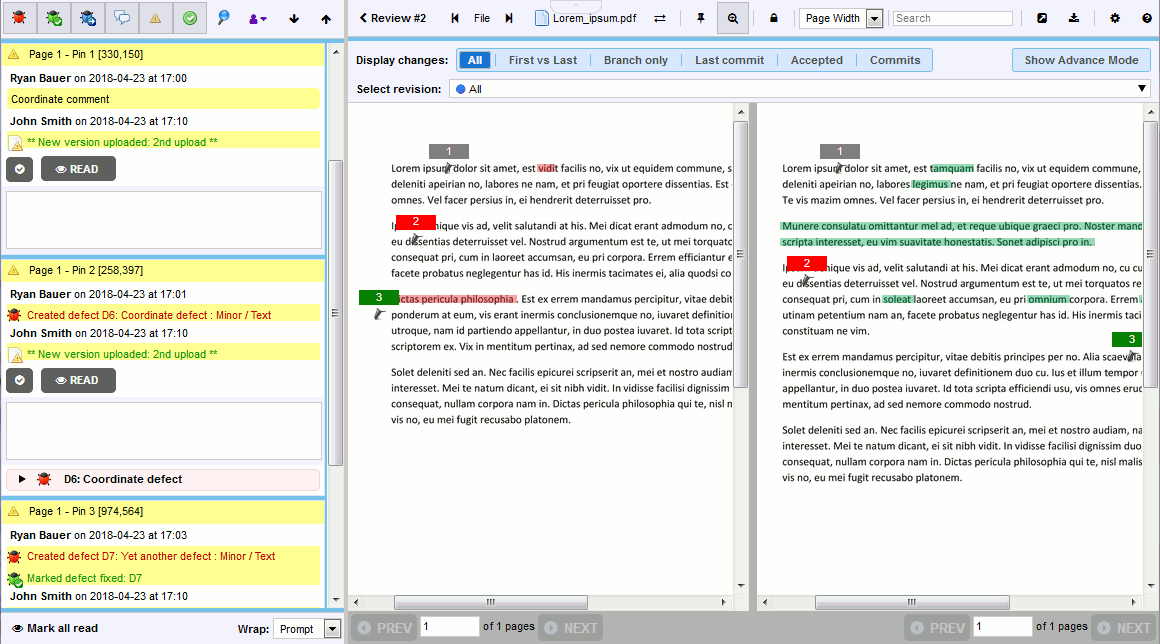 |
Document review is only supported on 64-bit Collaborator servers. On 32-bit platforms, Collaborator may fail to process the documents due to insufficient memory. |
 |
The Collaborator Visual Studio Extension and Eclipse Plug-in do not support reviewing PDF files. Use the Web Client instead. |
Collaborator includes native support for PDF files. Additionally, you may convert any other document type into PDF format and upload it to Collaborator.
Upload PDFs
To review PDF documents, just attach them to the review as you would any other file and when you open the Diff Viewer, the content area will display the documents for review.
Upload Arbitrary Document Types
To upload any arbitrary document, you need to convert the desired document to PDF format using a conversion tool and then upload it to the review. Popular converters include (but are not limited to):
View Differences
Documents can only be viewed in a single or side-by-side layout. There is no over-under view available currently for PDF documents.

Side-by-Side PDF Review
Scrollbars are available for each revision of the document. You are also able to move the separator to show more or less of either revision. To do this, drag the separator to the desired location.
Change Pages
To change pages, use the arrows at the bottom left of the comparison screen.

The arrows will allow you to go to the Previous Page or the Next Page. You can also manually enter a page number and select Enter to jump to an arbitrary page. The page numbers will refer to the latest upload of the document shown.
You can also use the mouse wheel to scroll through the pages (unless disabled by the respective option).
Zoom In And Out
Both the side-by-side and single view support zooming the images in the display. Zooming out is useful if the page is too large to display in the browser window without scrolling. Zoom is also useful for more precise placement of the comment markers. However, whether zoomed in or out, the comment markers still refer to pixel locations in the image at 100% zoom, so subpixel comments are not supported. If a zoom operation would cause the currently selected location to scroll offscreen, the image will be scrolled to recenter the selected location.
Rescaling of documents is performed by rerendering the document on the Collaborator server and could be slow depending on the size of the document and the selected image scale.
Make Comments and Mark Defects
Move Comment Pushpins
You can move an existing pushpin to a new position in a document. The feature works in Mozilla Firefox and Google Chrome, and should be enabled by administrator.
To move a comment:
-
Select the desired comment.
-
Click and hold the Move Comment handle (
 ).
). -
Drag the handle to the new position in the document.
Document Review Notes
-
If the DiffViewer has troubles displaying small characters, diagrams or documents look blurry, you will need to increase the resolution scale via the
com.smartbear.diff.image.resolution.scaleJava VM option, restart Collaborator server and clear browser cache.

On the left of the main Diff Viewer page, there is a pane for chat threads, where you can view and make comments and mark defects that should be fixed. When reviewing PDF files, you can create global, annotation, overall for file revision, coordinate (pushpin) and label comments and defects.
To comment on specific text in a document, simply click the document at a point where you would like your comment to appear and begin typing. Collaborator will insert a pushpin ( ) to indicate the comment. The number in the pushpin head corresponds to the comment's order within the current page of the document.
) to indicate the comment. The number in the pushpin head corresponds to the comment's order within the current page of the document.
You can hide pushpins by clicking the pushpin toggle button on the toolbar. Use this feature if a pushpin overlaps an important part of the document.
Alternatively, you may specify an arbitrary label, such as "Section 5.1", to describe the content you are referring to. Using labeled locations decreases the confusion that can occur when large changes occur in a text document resulting in the pushpins not being adjacent to the corresponding text. Label text may not be updated.
To learn more about communicating during the reviews, see Types of Review Comments and Defects and Review Chats, Comments, and Defects topics.